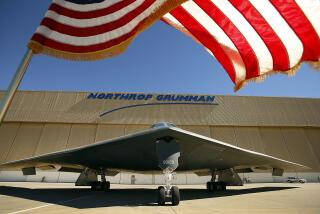Northrop Secretly Worked on Tank Weapon : Defense: The disclosure of a second major defense contract this month considerably brightens the company’s outlook.
- Share via
Northrop disclosed Tuesday that since 1984 it has been secretly developing a sophisticated Army munition to attack tanks--a program which has employed 250 people in recent years and ultimately could bring the Los Angeles aerospace firm revenue of $2.2 billion.
The munition, called the Bat, is the second major classified program at Northrop to emerge out of the “black” world in recent weeks. Earlier this month, the Pentagon disclosed the existence of the $15.1 billion Tri-Service Standoff Attack Missile.
The Army awarded Northrop a $344-million contract Thursday to complete the Bat’s development. The pact will run 42 months and provide a final design for production. Northrop said it will employ 500 workers on the design effort at its electronic systems division in Hawthorne.
Securities analysts said the disclosure of the two secret programs has significantly brightened prospects for Northrop. The B-2 bomber program, which accounts for half of the firm’s revenue, has gained a stronger position in Congress, as well, they said.
“With this new program and the earlier missile program, you have two very substantial programs,” said Prudential Securities analyst Paul Nisbet.
The programs prompted Nisbet to increase his earnings projections for the firm; he now foresees a doubling of profits over the next five years.
The Army said the Bat will be deployed from the Northrop tri-service missile as well as another Army missile, providing the ability to attack tanks at ranges exceeding 100 kilometers. It is intended to drop out of the missile and independently locate and destroy armored vehicles.
It may also mark a breakthrough in weapons guidance, because it uses a combination of infrared and acoustic sensors to find targets.
Weapons experts said they believe the Bat is the first weapon--other than those used under water--to employ an acoustic guidance system.
“It has been attempted in the past, but I don’t know of any fielded applications,” said a senior armament expert.
An acoustic sensor is akin to a microphone. In a guidance system, such a device would be severely degraded by air noise as the sensor moves through the airstream--something called “aerodynamic burbling,” the expert said.
“When you blow into a microphone, what do you get? And over that wind noise, you have to listen for target noise,” he said. Defeating such a system by creating false noise--a decoy playing a rendition of the sounds made by a tank, for instance--would be difficult, he said.
It is believed that initial work on the acoustic system began at Northrop’s electronics operation in Anaheim, which officials said was conducting significant amounts of research on acoustic systems in the early 1980s. That facility was later merged into the Hawthorne operation.
Northrop said it is continuing to study where it will produce the weapon. The company has declined to say where it will build the tri-service missile. It recently completed a new plant in Perry, Ga., but it remains unclear whether that plant would have the capacity to produce both the Bat and the tri-service missile.
The Army said that the projected unit cost of the Bat--so named because bats use acoustics to fly at night--is still classified. But the service did say that it has spent $250 million on the program so far; an additional $116.3 million has been budgeted for fiscal 1992. The Army said it has conducted 30 test flights of the device.
Raytheon is a major subcontractor to Northrop on the program. Both companies have cost-plus contracts, meaning that the firms do not face any financial risk on project overruns. The Army noted that Stealth technology does not play any role in the Bat program.
More to Read
Inside the business of entertainment
The Wide Shot brings you news, analysis and insights on everything from streaming wars to production — and what it all means for the future.
You may occasionally receive promotional content from the Los Angeles Times.











